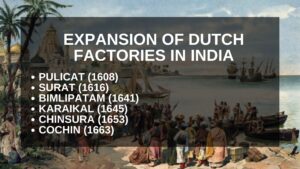Advent of Europeans in India
The advent of Europeans in India marked the beginning of modern Indian history. The long and arduous trade routes between India and Europe, passing through the Oxus Valley, Syria, and Egypt, motivated European nations to explore direct sea routes.
This period saw the arrival and competition of various European powers, including the Portuguese, Dutch, English, and French, each vying for dominance in the Indian subcontinent.
Download notes of Evaluation of Rajput States
The Dutch in India
Dutch Arrival in India
- The Dutch are an ethnic group native to the Netherlands.
- Cornelis de Houtman was the first Dutchman to reach Bantam and Sumatra in Indonesia in 1596.
- The Dutch East India Company (VOC) was established in 1602 and was granted powers to wage war, conclude treaties, acquire territory, and build fortresses.
- Their first factory in India was set up at Masulipatnam in 1605.
- Other key Dutch settlements included Pulicat (1610), Nagapatnam (1690), and Sadras (1818).
Expansion and Trade
- The Dutch expanded their presence in Gujarat, Bihar, Bengal, and Uttar Pradesh.
- Key Dutch factories:
-
- Pulicat (1608)
- Surat (1616)
- Bimlipatam (1641)
- Karaikal (1645)
- Chinsura (1653)
- Cochin (1663)

- Dutch trade items:
- Saltpetre (Bihar)
- Indigo (Yamuna Valley and Central India)
- Opium and rice (Ganga Valley)
- Textiles and silk (Coromandel, Bengal, and Gujarat)
Conflicts and Decline
- Conflict with the Portuguese: The Dutch captured Nagapatnam from the Portuguese in 1658 and helped expel them from Cochin in 1663.
- Conflict with the English: The Anglo-Dutch rivalry led to the massacre of English traders at Amboyna (1623). The Treaty of 1667 resulted in Dutch withdrawal from India.
- Decline: The Dutch were defeated in the Battle of Biderra (1759), leading to their retreat from India.
The English in India
English Arrival and Expansion
- Francis Drake’s expedition (1580) and the defeat of the Spanish Armada (1588) boosted English maritime ambitions.
- Queen Elizabeth I granted a charter to the East India Company (EIC) on December 31, 1600.
- Captain William Hawkins reached the Mughal court (1609) but was denied permission for a factory.
- First factory in Masulipatnam (1611); followed by Surat (1612), Ahmedabad, Broach, and Agra (1615).
Major Developments
- War with Portuguese (1612): Captain Thomas Best defeated the Portuguese, leading to EIC’s factory in Surat.
- Bombay (1662-1668): King Charles II received Bombay as dowry and transferred it to the EIC.
- Golden Farman (1632): Allowed EIC to trade freely in Golconda.
- Expansion in Bengal:
-
- Factory in Hooghly (1651).
- Farmans from Mughal emperor Farrukhsiyar (1715) granted trade privileges.
- Foundation of Calcutta (1690) and establishment of Fort William (1700).
Rise of British Political Power
- Anglo-Mughal Conflict: The EIC’s armed conflicts with the Mughals in Bengal culminated in the Treaty of 1691, allowing duty-free trade.
- Rival English Company (1698): Merged with the original EIC in 1708 to form the United Company of Merchants of England Trading to the East Indies.
The French in India
French Arrival and Settlements
- The French East India Company was founded in 1664 under King Louis XIV.
- First factory established in Surat (1668) and Masulipatnam (1669).
- Key French territories:
-
- Pondicherry (1674)
- Chandernagore (1673)
- Mahe (1725)
- Karaikal (1739)
Anglo-French Rivalry: The Carnatic Wars
First Carnatic War (1740-1748)
- Initiated due to European conflicts (Austrian War of Succession).
- Treaty of Aix-La-Chapelle (1748) restored Madras to the British.
Second Carnatic War (1749-1754)
- Resulted from succession disputes in Hyderabad and Carnatic.
- British victory at Arcot (1751) weakened French influence.
Third Carnatic War (1758-1763)
- Part of the Seven Years’ War.
- Battle of Wandiwash (1760): British General Eyre Coote defeated the French, leading to their political downfall in India.
- Treaty of Paris (1763) confined French presence to a few enclaves.
Why the British Succeeded Over Other European Powers
Strategic and Organizational Superiority
- Efficient Administration: The British East India Company was well-structured, unlike state-controlled French and Portuguese companies.
- Naval Dominance: The British Royal Navy outmatched the fleets of rival European powers.
- Industrial Revolution: Provided economic and military advantages.
- Stable Government: Britain’s political stability contrasted with the turmoil in France and Portugal.
- Military Prowess: Disciplined troops and innovative military tactics.
- Financial Strength: The Bank of England’s use of debt markets enabled extensive war funding.
Download notes of Chola Dynasty History
The advent of Europeans in India was a turning point in Indian history, laying the foundation for British colonial rule. The Portuguese, Dutch, and French played significant roles but ultimately failed against the superior strategy and resources of the British.
The East India Company’s steady expansion eventually led to complete British control over India, shaping the nation’s destiny for the next two centuries.


